

Power of Social media in Education. A Pinterest User Has Been Attributing Hitler Quotes To Taylor Swift. Can Technology Help Students Become Better Writers? Send a list of your last dozen text messages to your high school English teacher and it’s easy to imagine him or her cringing at the sentence fragments, the misspellings, and, oh, the syntax.
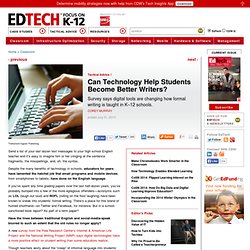
Despite the many benefits of technology in schools, educators for years have lamented the hatchet job that email programs and mobile devices, from smartphones to tablets, have done on the English language. If you’ve spent any time grading papers over the last half-dozen years, you’ve probably bumped into a few of the more egregious offenders—acronyms such as LOL (laugh out loud) and ROFL (rolling on the floor laughing) have been known to sneak into students’ formal writing.
There’s a place for this brand of hurried shorthand—on Twitter and Facebook, for instance. But in a school-sanctioned book report? As part of a term paper? Have the lines between traditional English and social-media-speak blurred to such an extent that the old rules no longer apply? 25 Ways Teachers Can Integrate Social Media Into Education. Connectivism: Its place in theory-informed research and innovation in technology-enabled learning.
Special Issue - Connectivism: Design and Delivery of Social Networked Learning Frances Bell University of Salford, United Kingdom Abstract The sociotechnical context for learning and education is dynamic and makes great demands on those trying to seize the opportunities presented by emerging technologies.
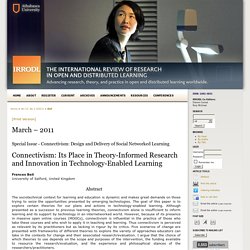
Social Media in Education – Part 5. Written by Mark Brumley Twitter Alternatives Microblogging is an excellent activity for students, however, your school may not allow Twitter. Or, if your students do not have school email accounts, it may be a challenge for students to create an actual Twitter ID. No worries! Alternatives exist that are just as good and work great for students. No account microblogging Without a doubt the easiest microblogging site to use in the classroom is TodaysMeet . More Twitter alternatives. Technology Integration Research: Annotated Bibliography. Adams, W.K. (2010).
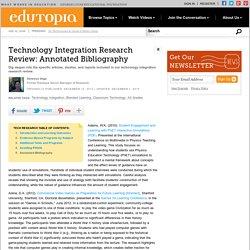
Student Engagement and Learning with PhET Interactive Simulations (PDF). Presented at the International Conference on Multimedia in Physics Teaching and Learning. This study focuses on understanding how students use Physics Education Technology (PhET) simulations to construct a mental framework about concepts and the effect levels of guidance have on students' use of simulations. Hundreds of individual student interviews were conducted during which the students described what they were thinking as they interacted with simulations.
Careful analysis reveals that showing the invisible and use of analogy both facilitate students' construction of their understanding, while the nature of guidance influences the amount of student engagement. Arena, D.A. (2012). Arici, A. (2008). Bakia, M., Shear, L., Toyama, Y., and Lassseter, A. (2012). Rapid Rise Seen in Use of Digital Tools for PD. Sign In. 5 best practices to consider when using Facebook with students SmartBlogs. Innovative educators realize that to run for office, to run a business or to change the way things are run where one works or plays, being savvy with social media is important.
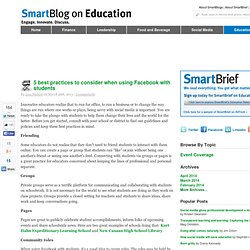
You are ready to take the plunge with students to help them change their lives and the world for the better. Before you get started, consult with your school or district to find out guidelines and policies and keep these best practices in mind. Friending Some educators do not realize that they don’t need to friend students to interact with them online. You can create a page or group that students can “like” or join without being one another’s friend or seeing one another’s feed. Groups Private groups serve as a terrific platform for communicating and collaborating with students on schoolwork. Pages Pages are great to publicly celebrate student accomplishments, inform folks of upcoming events and share schoolwide news.
Community roles When using Facebook with students, it’s a good idea to create roles. Investigating instructional strategies for using social media in formal and informal learning. Baiyun Chen and Thomas Bryer University of Central Florida, USA Abstract Despite the high popularity of personal use of online social media, a low percentage of students and instructors use them for educational purposes.

This qualitative study explores the use of social media among faculty in the discipline of public administration in the United States. Activities. #STEMchat. The Maker Mom sponsors monthly #STEMchats on Twitter designed to bring parents, educators and STEM professionals together to share resources and ideas to raise STEM-loving kids.
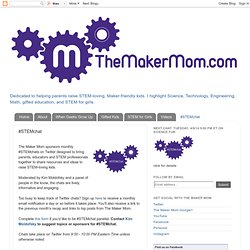
Moderated by Kim Moldofsky and a panel of people in the know, the chats are lively, informative and engaging. Too busy to keep track of Twitter chats? Sign up here to receive a monthly email notification a day or so before it takes place. You'll also receive a link to the previous month's recap and links to top posts from The Maker Mom. Complete this form if you'd like to be #STEMchat panelist. Chats take place on Twitter from 9:00 - 10:00 PM Eastern Time unless otherwise noted. Marine Science and Animal Care Careers Featuring Expert Ken Ramirez from Chicago's Shedd Aquarium. Science FunDiscovery Education 3M Young Scientist Challenge April 8, 2014Panelists. Our first #STEMchatOnAir! Women's History Month: A STEM PerspectiveGeorgia-Pacific March 18, 2014Panelists.
Articles on How Social Media and Technology HELP, Not Hurt, Education. Motorcycling through Vietnam, Social Media kept me connected, protected, and sane!

How Social Media is Blurring Lines in Education. Guest post by Starr Sackstein Defining appropriate relationships within education used to be simple.
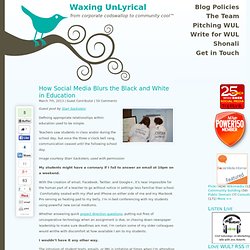
Teachers saw students in class and/or during the school day, but once the three o’clock bell rang, communication ceased until the following school day. Image courtesy Starr Sackstein, used with permission. College Guide. Digital media transforms teaching, learningKeeping up with the timesBy tina hinz, tina.hinz@wcfcourier.com CEDAR FALLS --- Textbooks are "so last century" as today's digital world transforms the world of teaching and learning.
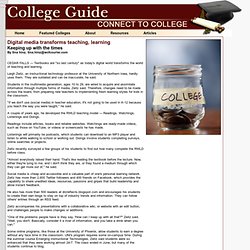
Leigh Zeitz, an instructional technology professor at the University of Northern Iowa, hardly uses them. They are outdated and can be inaccurate, he said. Students in the multimedia generation, ages 10 to 29, are wired to acquire and assimilate information through multiple forms of media, Zeitz said. Therefore, changes need to be made across the board, from preparing new teachers to implementing fresh learning styles for kids in the classroom. "If we don't use (social media) in teacher education, it's not going to be used in K-12 because you teach the way you were taught," he said. A couple of years ago, he developed the RWLD teaching model --- Readings, Watchings, Listenings and Doings. Elana Leoni On Social Media-Driven Teacher Improvement.
In an Edudemic+ session, Terry Heick (@/+terryheick) chats with Elana Leoni (@/+elanaleoni) of Edutopia (@/+edutopia) about the role of technology in teacher improvement, especially social media. The following is an excerpted transcription of that conversation. Lisa Dabbs also participated in the session, and her comments will appear in a proceeding transcription. Also appearing are comments by Amy Borovoy (@videoamy), also from Edutopia Terry: One thing that sets Edutopia apart from other organizations is the use of video, and technology in general – it seems to be something Edutopia really embraces.
Why do you feel video in particular is so important? Elana: We get a lot of feedback from our audience that video can show a lot of things you can’t really describe, and you can take videos to a supervisor and actually show them what you want to be able to do – it’s more persuasive than a white paper. Beyond Facebook: Leveraging social networks in STEM education and research SmartBlogs. Before social networks, e-mail, and even before the telephone, scientists regularly communicated with their peers by mail and in person.
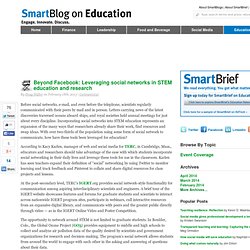
Letters carrying news of the latest discoveries traversed oceans aboard ships, and royal societies held annual meetings for just about every discipline. Incorporating social networks into STEM education represents an expansion of the many ways that researchers already share their work, find resources and swap ideas. With over two-thirds of the population using some form of social network to communicate, how have these tools been leveraged for education?